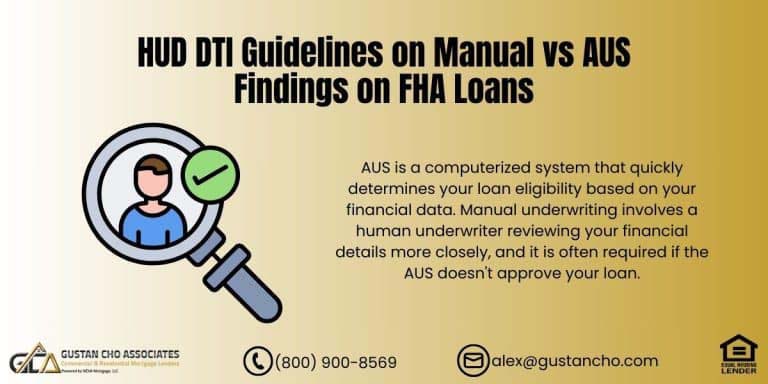This article will explore the HUD CAIVRS Guidelines for FHA loans when obtaining a mortgage. Government-backed mortgage loans are an excellent option, particularly for those who have struggled to qualify for conventional financing. However, there’s a caveat: you can only qualify for these loans if your CAIVRS report is clear. If you need clarification on what that means, don’t worry! This article will explain the report’s details and how it relates to FHA loan guidelines. Keep reading to discover more.
What is CAIVRS?
CAIVRS is a government list of people who are behind on federal debts. If you’re on it, you can’t get an FHA, VA, or USDA loan until you clear your debts. The U.S. Department of Housing and Urban Development (HUD) created CAIVRS in 1987 to keep track of issues like liens, judgments, defaults, and foreclosures. When you apply for one of these loans, your lender will check your CAIVRS report to see if you’re eligible.
HUD’s guidelines state that if you have delinquent federal debt, you are not allowed to get any federal loans backed by the government. This ensures that applicants for federal mortgages aren’t trying to take out new loans while still owing money on government-backed debts.
However, if you’re applying for a non-credit-qualifying FHA streamline refinance, you can be exempt from this rule since those loans are based on your current mortgage and ability to make on-time payments. In these cases, the new CAIVRS data is less important for deciding eligibility.
What is a CIAIVRS Authorization?
CAIVRS (Credit Alert Interactive Voice Response System) authorization is used by the U.S. federal government to assess a person’s creditworthiness and eligibility for government-backed loans. Managed by the Department of Housing and Urban Development (HUD), the CAIVRS database identifies delinquent individuals who have defaulted on federal debts or have had claims paid on federally insured loans.
When you apply for specific government-backed loans (like FHA, VA, or USDA), lenders check your status in CAIVRS to verify that you’re not listed as having federal debt delinquencies or defaults according to HUD CAIVRS Guidelines.
You may be denied these loans if your name is allowed in the database once the issues are resolved. A clear CAIVRS authorization indicates that you aren’t flagged for these problems and can proceed with the loan approval process.
Ready to Apply for an FHA Loan? Understand the HUD CAIVRS Guidelines
Contact us today to learn how CAIVRS impacts your FHA loan application and what steps you need to take.
HUD CAIVRS Guidelines on FHA loans
Now that you know about CAIVRS let’s see how it relates to FHA loans. When you apply for an FHA loan, the lender must check the CAIVRS database to assess your creditworthiness. If you have any defaulted federal debt, you may not be eligible for an FHA loan. The lender uses CAIVRS to make sure you have no such debts. If you owe money on student loans or federal taxes, it can disqualify you from getting an FHA loan.
Defaulting on federal debt shows financial irresponsibility and can hurt your credit score. Also, if you have faced foreclosure, it can affect your CAIVRS eligibility.
What are the Requirements for a DTI for a FHA Loan?
For Federal Housing Administration (FHA) loans, lenders generally follow these guidelines for the debt-to-income (DTI) ratio:
- Front-End Ratio (Housing Ratio): This measures your monthly housing costs against your gross monthly income. Based on the criteria for an FHA loan, it is important to ensure that your housing expenses, which include payments towards principal, interest, taxes, and insurance, do not exceed 31% of your gross monthly income.
- Back-End Ratio (Total DTI Ratio): This includes all your monthly debt payments (credit card bills, car loans, student loans, etc.) compared to your gross monthly income. The maximum back-end ratio for FHA loans is 43% of your monthly income before taxes and other deductions.
These ratios are flexible, though, and higher ratios may be allowed in certain cases, especially if the borrower has strong compensating factors like high credit scores, additional income, or substantial savings. Ultimately, the final decision is at the lender’s discretion within the FHA guidelines.
HUD CAIVRS Guidelines on Foreclosure
According to the HUD CAIVRS guidelines, any foreclosure on an FHA loan renders the borrower ineligible for a new FHA loan for a specified period. This period varies based on the severity of the default and other contributing factors, such as the reason for foreclosure. For instance, a borrower who experienced foreclosure due to extenuating circumstances like medical bills or job loss might qualify for a new loan sooner than someone whose foreclosure resulted from financial mismanagement.
HUD CAIVRS Guidelines on Delinquent Federal Debt
Under the HUD CAIVRS Guidelines, you can’t get an FHA loan if you have unpaid federal debts like overdue child support or defaulted SBA loans. These debts suggest you struggle financially, which can hurt your credit score.
For example, if you haven’t paid child support for several months or failed to repay a loan from the Small Business Administration, your name may show up in the CAIVRS database. If that happens, lenders might deny your FHA loan application or ask for more paperwork or a larger down payment. They might also want to know why you defaulted on the federal debt before deciding your loan eligibility.
How Can You Tell If You Are on CAIVRS?
If you’re concerned about being listed in CAIVRS due to potential default on federal debt, it’s important to take proactive steps. First, you can avoid confusion by contacting the Department of Education or the Small Business Administration (SBA) if you suspect you have a defaulted loan. They can provide information about your status without the need to apply for a loan.
Remember, not all defaults or foreclosures are accurately recorded in the HUD system, so checking with these agencies can give you clarity. If you are listed in CAIVRS, your name will appear in their database, but confirming your status through these channels may help you prepare before applying for federal loans.
If you apply for a loan and do not receive a clean financial history pass (“A” result code), don’t be discouraged—you might still qualify. In this case, it’s crucial to provide documentation showing that you’ve made efforts to resolve your default by making regular payments for a set period, like resuming timely payments on a student loan for at least nine months. This evidence can be key in helping lenders see that you’re taking significant steps to improve your financial situation. Each FHA-approved lender has specific criteria for approval, so understanding these details can be beneficial.
How To Clear a CAIVRS Default
Clearing a CAIVRS default can be a critical step if you’re looking to obtain government-backed financing like FHA loans. Here’s how to address it:
- Identify the Delinquency Source:
- Determine which federal debt (student loan, Small Business Administration loan, etc.) triggered your inclusion in the CAIVRS database.
- Contact the Creditor Agency:
- Contact the agency responsible for the debt (e.g., the Department of Education for student loans) directly. Ask for information regarding the outstanding debt or the delinquency.
- Set Up a Repayment Plan:
- If you cannot pay off the entire amount immediately, negotiate a repayment plan with the agency. Adhering to this plan consistently may help restore your eligibility.
- Request Documentation:
- Obtain a written confirmation from the agency when the debt is settled or under a payment arrangement. This document will be necessary to clear your CAIVRS record.
- Provide Documentation to Your Lender:
- Submit this documentation to your FHA lender to prove you’ve resolved the default issue. The lender will then clear the CAIVRS record.
- Contest Inaccuracies (if applicable):
- Suppose you believe that your record in CAIVRS is incorrect. In that case, you can dispute the error directly with the agency that listed you. If the error is verified, they can remove your name from CAIVRS.
- Rebuild Your Credit:
- Once you have addressed your CAIVRS default, it is crucial to enhance your credit score and reduce your debt-to-income ratio, as this can improve your likelihood of being approved for future loans.
Following these steps can help you get on the right path to securing a government-backed loan again.
Navigating HUD CAIVRS for FHA Loan Approval
Get in touch today to find out if you’re affected by CAIVRS and how we can help you get your loan approved.
HUD CAIVRS Guidelines on Debt Rehabilitation
To clear your CAIVRS report, the easiest method is to pay off any outstanding debt to the agency that gave you the loan. Dale Elenteny highlights that different lenders have different rules for CAIVRS reports.
Of course, paying the debt in full is the best way to qualify for a loan. However, some lenders might allow you to make a payment plan, and making several on-time payments could be enough to qualify you. Other lenders may need you to pay off the debt completely before they approve you. It’s a good idea to contact your FHA-approved lender to find out what steps you should take next.
HUD CAIVRS Guidelines on Errors
If you find any mistakes on your CAIVRS report, you have the legal right to contest them. If the errors are confirmed, the issues will be resolved, and your report will be updated.
For those with student loans, a helpful option is a “direct consolidation loan.” This process can help you get your student loans out of default quickly—usually within six months—at no cost.
Imagine Sarah, who has fallen behind on her federal student loans and found her name on the CAIVRS report, which affected her ability to apply for a home loan. When she noticed inaccuracies about her loan status, she decided to contest them by gathering her loan statements and contacting the appropriate agency.
While waiting for the inaccuracies to be corrected, Sarah learned about direct consolidation loans. She applied for one, which allowed her to combine her defaulted student loans into a single new loan. Within six months, her loans were removed from default, and her name was cleared from the CAIVRS report. Thanks to this process, she can move forward with purchasing a home!
By understanding these options, Sarah took control of her financial situation and successfully resolved the issues with her loans.
HUD CAIVERS Guidelines on Fixing Errors To Qualify For FHA Loans
Suppose you consider applying for an FHA mortgage and believe you might be on the CAIVRS database. In that case, it will be a good idea to start working with an FHA lender to rectify the situation. For the most part, you need to take steps and pay off the delinquent debt or maybe set up a payment plan. Keep building a credit habit and clear up any negative marks on your credit history. Ultimately, do your due diligence to ensure you become a creditworthy borrower once again before you embark on the loan application process.
FAQ: FHA Loan DTI Ratios and CAIVRS Authorization
Q: What is the Front-End Ratio (Housing Ratio) for FHA Loans?
A: The front-end or housing ratio compares your gross monthly income to your monthly housing expenses. For FHA loans, this ratio should not be more than 31%. Housing expenses include interest, principal, taxes, and insurance.
Q: What is the Back-End Ratio (Total DTI Ratio) for FHA Loans?
A: The back-end ratio refers to the proportion of your gross monthly income dedicated to paying off your monthly debts, including credit card bills, car loans, student loans, and other bills. It is recommended that the back-end ratio for FHA loans should be at most 43% of your gross monthly income.
Q: Are Exceptions Made to the FHA DTI Guidelines?
A: Exceptions can be made if the borrower has strong compensating factors, such as high credit scores, additional income, or significant savings. However, the lender makes the final decision.
Q: What is CAIVRS, and Why is it Important for FHA Loans?
A: CAIVRS (Credit Alert Interactive Voice Response System) is a government database managed by HUD that lists individuals with federal debt delinquencies, defaults, or foreclosures. Before approving your FHA loan application, lenders check this database to ensure you’re not on the list.
Q: What Happens if My Name is in the CAIVRS Database?
A: If your name is listed in the CAIVRS database due to federal debt defaults or delinquencies, you may be denied an FHA loan unless you resolve the issues.
Q: How Can I Clear My Name from the CAIVRS Database?
A: To clear your name, you may need to pay off outstanding federal debts, set up a payment plan, or contest inaccuracies in the report. Each federal agency may have different processes, so it’s important to work directly with your FHA lender.
Q: Are all FHA Loans Affected by CAIVRS Findings?
A: FHA Streamline Refinance loans are generally exempt from this rule because they are based on existing mortgages rather than new credit checks.
Q: How do I Know if I’m in the CAIVRS Database?
A: If you’ve defaulted on federal debt, you’re likely in the CAIVRS database. However, the only way to confirm is through an FHA lender who will access the database when you apply for a government-backed loan.
Q: What Should I do if I’m in the CAIVRS Database but Need an FHA Loan?
A: Contact your FHA lender and follow their instructions to clear your name. This often involves paying off debts or setting up a repayment plan.
Q: Can Foreclosure Affect My CAIVRS Eligibility for FHA Loans?
A: Yes, suppose you’ve had a foreclosure on a federal loan. In that case, you may be ineligible for an FHA loan for a specified period. This timeframe depends on the severity and cause of the default.
If you have any questions about FHA Loan DTI Ratios and CAIVRS Authorization or you need to qualify for loans with a lender with no overlays on government or conforming loans, please contact us at 800-900-8569. Text us for a faster response. Or email us at alex@gustancho.com. The team at Gustan Cho Associates is available 7 days a week, on evenings, weekends, and holidays.
This blog about “FHA Loan DTI Ratios and CAIVRS Authorization” was updated on April 22nd, 2025.
Have a CAIVRS Flag on Your FHA Loan Application?
Reach out now for expert guidance on how to clear your CAIVRS record and move forward with your home purchase.











